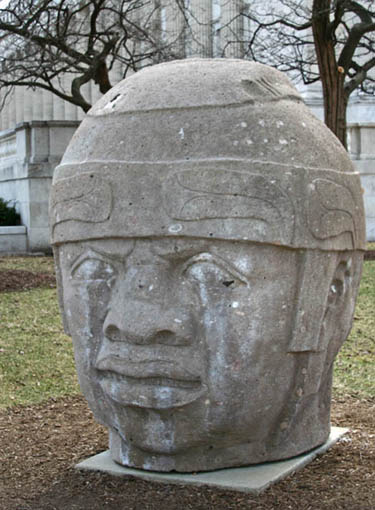Artist:
Ignacio Perez Solano
Title:
Head Number 8, Replica
Year:
-900
Adress:
Museum Campus
www.publicartinchicago.com:
The ancient Olmec, one of the first complex societies in the Americas, are remembered for their colossal head sculptures, 17 of which have been recovered to date. Each original head is distinctive and believed to embody the likeness of an individual leader. Though all of the heads were carved in a stylized manner, Olmec Head #8 is considered the most naturalistic. The State of Veracruz, Mexico donated Ignacio Perez Solano’s 1700-pound stone replica to the City of Chicago.
The plaque reads ..." This sculpture is a replica of Olmec Head #8 from the site of San Lorenzo. It is one of 17 known colossal heads created by the ancient Olmec people in the states of Veracruz and Tobasco, Mexico. The Olmec flourished in the Gulf Coast region of Mexico from 1300 to 300 BC. Most scholars believe that Olmec carved these stone heads to commemorate their rulers."
Another plaque reads:" Olmec Head, Number 8, Gift of the Government of the State of Veracruz, Mexico and Miguel Aleman, Governor of Veracruz, to the People of Chicago. Dedicated October 21, 2003. City of Chicago. Richard M Daley, Mayor. City of Chicago Public Art Collection." www.wikipedia.org:
The Olmec colossal heads are at least seventeen monumental stone representations of human heads sculpted from large basalt boulders.
The heads date from at least before 900 BC and are a distinctive feature of the Olmec civilization of ancient Mesoamerica.
All portray mature men with fleshy cheeks, flat noses, and slightly crossed eyes; their physical characteristics correspond to a type that is still common among the inhabitants of Tabasco and Veracruz.
The backs of the monuments often are flat. The boulders were brought from the Sierra de los Tuxtlas mountains of Veracruz. Given that the extremely large slabs of stone used in their production were transported over large distances, requiring a great deal of human effort and resources, it is thought that the monuments represent portraits of powerful individual Olmec rulers.
Each of the known examples has a distinctive headdress. The heads were variously arranged in lines or groups at major Olmec centres, but the method and logistics used to transport the stone to these sites remain unclear.
The ancient Olmec, one of the first complex societies in the Americas, are remembered for their colossal head sculptures, 17 of which have been recovered to date. Each original head is distinctive and believed to embody the likeness of an individual leader. Though all of the heads were carved in a stylized manner, Olmec Head #8 is considered the most naturalistic. The State of Veracruz, Mexico donated Ignacio Perez Solano’s 1700-pound stone replica to the City of Chicago.
The plaque reads ..." This sculpture is a replica of Olmec Head #8 from the site of San Lorenzo. It is one of 17 known colossal heads created by the ancient Olmec people in the states of Veracruz and Tobasco, Mexico. The Olmec flourished in the Gulf Coast region of Mexico from 1300 to 300 BC. Most scholars believe that Olmec carved these stone heads to commemorate their rulers."
Another plaque reads:" Olmec Head, Number 8, Gift of the Government of the State of Veracruz, Mexico and Miguel Aleman, Governor of Veracruz, to the People of Chicago. Dedicated October 21, 2003. City of Chicago. Richard M Daley, Mayor. City of Chicago Public Art Collection." www.wikipedia.org:
The Olmec colossal heads are at least seventeen monumental stone representations of human heads sculpted from large basalt boulders.
The heads date from at least before 900 BC and are a distinctive feature of the Olmec civilization of ancient Mesoamerica.
All portray mature men with fleshy cheeks, flat noses, and slightly crossed eyes; their physical characteristics correspond to a type that is still common among the inhabitants of Tabasco and Veracruz.
The backs of the monuments often are flat. The boulders were brought from the Sierra de los Tuxtlas mountains of Veracruz. Given that the extremely large slabs of stone used in their production were transported over large distances, requiring a great deal of human effort and resources, it is thought that the monuments represent portraits of powerful individual Olmec rulers.
Each of the known examples has a distinctive headdress. The heads were variously arranged in lines or groups at major Olmec centres, but the method and logistics used to transport the stone to these sites remain unclear.



